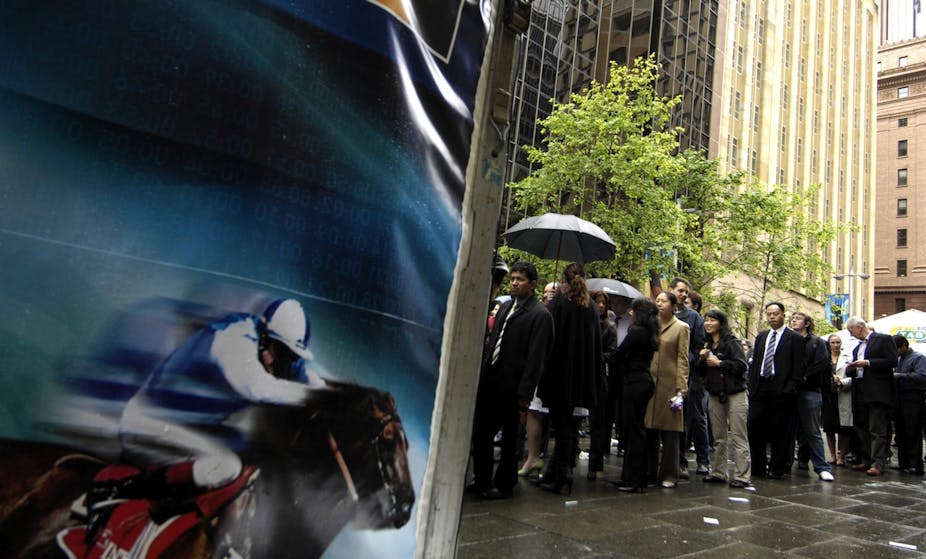In the lead-up to next week’s Melbourne Cup, bookmaker Tom Waterhouse is heavily marketing a “$25 million bet that stops a nation”. All you have to do is give him A$10 and if you place the first 10 horses in correct finishing order in the Cup you have a chance, stress “have a chance”, to win A$25 million. If other punters happen to place the same bet, then you’ll have to share the $25 million with them.
Tom’s number crunchers will have done their sums, of course, so he’ll know that the probability of any person correctly placing the first 10 horses is extremely low. In fact, it’s likely to be much lower than we might expect. As Princeton University psychologist Daniel Kahneman found, in Nobel Prize-winning work with Amos Tversky, humans overestimate the probability of rare events occurring. Bookies love that flaw in our mental processing ability.
The odds of winning OZ Lotto are disclosed as one in 45 million, while the odds of winning Powerball are disclosed as one in 76 million. A bit of standard probability analysis shows that your odds of winning with Tom may be estimated to be significantly lower.
Assuming no scratchings, 24 horses could start the race. Note also that the fine print of Tom’s offer provides that bets will be null and void if there are fewer than 20 runners. But let’s assume you have a considerable head start as a punter – a head start that you almost certainly won’t have in reality. You know that only 20 horses are going to start the race and you know that fact before placing your bet.
This helpful assumption – helpful at least from Tom’s side of the bet - is of course extremely unrealistic and unlikely. The final field will not be declared until the weekend before the running of the Cup and there are likely to be more than 20 runners.
To make the calculation tractable we need to make the standard assumption first applied to horse racing by the statistician David Harville – namely that of conditional independence. If we also assume for simplicity that the horses have equal chances in the race, then the probability of correctly selecting the winner is one in 20, the probability of then selecting the second-placed horse is one in 19 (given the same horse can’t finish first and second) and so on down to the probability of correctly selecting the tenth-placed horse being one in 11.
So a bit of mathematics (20 x 19 x 18 x 17 x 16 x 15 x 14 x 13 x 12 x 11) provides that the probability of correctly selecting the first 10 horses in correct order is one in 670,442,572,800. Let’s round that down to 670 billion. So a “fair” bet would see the punter receive 670 billion times $10 or $6.7 trillion if he or she won.
Of course, Tom’s number crunchers will say that the horses don’t have equal chances of winning. This does change the probabilities a bit.
Suppose we take the most likely finishing order of the top 10 horses, which is that the favourite finishes first, the second favourite finishes second, and so on. Using the odds for the top ten favourites in last year’s Cup, or the current fixed-price odds for this year’s Cup, and assuming that only 20 horses start, estimates of the odds of correctly placing the first ten horses are still of the order of one in hundreds of millions. That suggests a fair “bet” would see the punter receive billions not millions if he or she won.
Enjoy Melbourne Cup day. But perhaps consider making a donation to beyondblue rather than to Tom.

